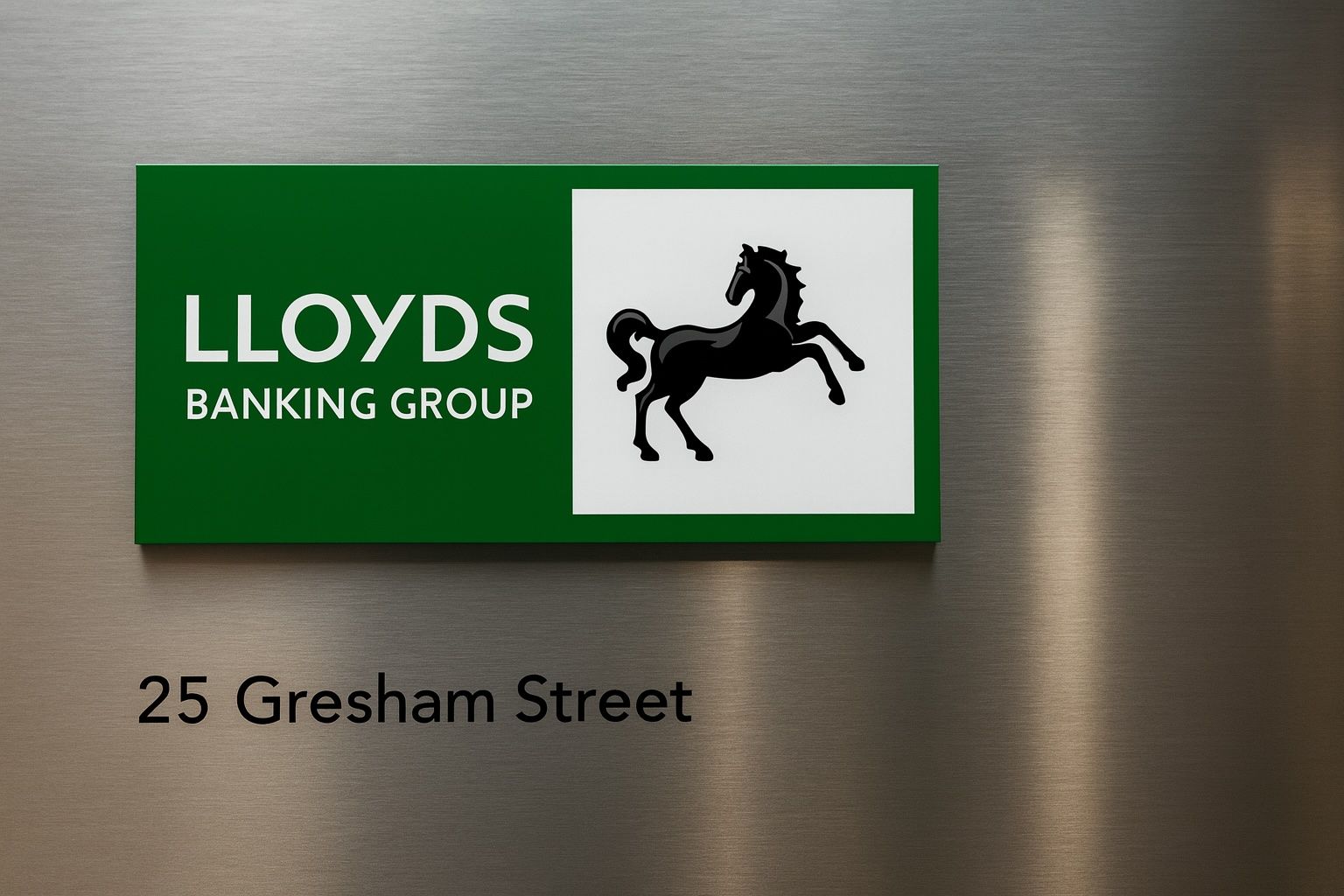After years of being one of the UK market’s biggest underperformers, Lloyds Banking Group (LSE: LLOY) has staged a striking comeback in 2025. The share price has surged roughly 60–65% year to date and recently touched a 10‑year high, comfortably beating the FTSE 100 and most domestic peers. [1]
Yet the rally comes with baggage: a multibillion‑pound motor finance scandal, a changing UK interest‑rate environment and fresh questions over how far the stock can run before the end of 2025.
Below is a detailed, news‑driven look at Lloyds’ latest results, its risk profile and what current analyst forecasts suggest for the shares between now and 31 December 2025.
Where the Lloyds share price stands now
Lloyds shares have climbed from the low‑60p range at the start of 2025 to the high‑80s and low‑90s in November, hitting a new 52‑week peak of about 95.9p on 12 November. [2]
As of 20 November 2025, the stock was trading around 87–88p on the London Stock Exchange, roughly 8–9% below that recent high but still up more than 60% year to date. [3]
Over a longer horizon, some data providers estimate that total shareholder returns have exceeded 200% over the past five years, reflecting both capital gains and dividends. [4]
That sharp rerating naturally raises the key question: has Lloyds’ fundamental outlook improved enough to justify further gains into year‑end, or has the share price moved ahead of itself?
2025 financial performance: strong core earnings, one big drag
Lloyds’ third‑quarter (Q3) 2025 results, released on 23 October, give the clearest snapshot of the bank’s current health.
Headline numbers
- Statutory pre‑tax profit for Q3 fell about 36% year on year to £1.17bn, mainly due to a large provision for mis‑sold motor finance. [5]
- Year‑to‑date (YTD) net income reached around £13.6bn, up 6% versus the same period in 2024, with Q3 income up 3% quarter on quarter. [6]
- Net interest income (NII) – the core profit Lloyds earns from lending minus funding costs – is now guided to be about £13.6bn for full‑year 2025, an upgrade from earlier guidance. [7]
- YTD return on tangible equity (RoTE) stands at roughly 11.9%, or 14.6% if you strip out the latest motor‑finance provision. [8]
In plain English: the underlying banking business (mortgages, retail loans, commercial lending and related fees) is performing solidly, with growing income and healthy returns, but the motor‑finance issue is temporarily masking that strength.
Balance sheet and capital
Capital remains one of Lloyds’ main safety cushions:
- The Common Equity Tier 1 (CET1) ratio was about 13.6–13.8% at 30 September 2025, versus 13.7% at the end of 2024. [9]
- Management now expects to generate roughly 145 basis points (1.45 percentage points) of capital in 2025, or about 175 bps excluding motor‑finance charges. [10]
These levels are comfortably above regulatory minimums and give the board flexibility to continue paying dividends and potentially return more capital over time, even after absorbing further remediation costs.
Dividends: income appeal remains a key part of the story
Income investors continue to see Lloyds as a dividend stock, and 2025 has reinforced that narrative:
- With the 2025 half‑year results, Lloyds announced an interim ordinary dividend of 1.22p per share, up 15% from the prior year, and reiterated its “progressive and sustainable” dividend policy. [11]
- Based on the current share price and recent payouts, various data providers estimate Lloyds’ forward dividend yield at around the mid‑single digits (roughly 3.8–4%). [12]
For 2025 as a whole, the market is broadly expecting a modestly higher total dividend than in 2024, supported by growing earnings and strong capital generation.
The motor finance scandal: the biggest overhang on the shares
The largest known risk to the investment case remains the UK motor finance mis‑selling scandal.
The Financial Conduct Authority (FCA) is designing a redress scheme related to “discretionary commission arrangements” in car finance, where lenders and dealers were incentivised to charge higher interest rates over many years. Early estimates suggested industry‑wide costs could be as high as £11–12bn. [13]
Lloyds, via its Black Horse division, is the most exposed of the major UK banks:
- The bank has set aside about £1.95bn in provisions so far, including an additional £800m charge in Q3 2025. [14]
- Analysts at Citi and other firms have warned that Lloyds may still need hundreds of millions more if the final FCA rules are less favourable than hoped. [15]
- The FCA recently extended its consultation deadline from 18 November to 12 December 2025, pushing definitive clarity into 2026; final rules are expected around February or March. [16]
One piece of good news: a Supreme Court ruling earlier in the year went largely in favour of banks, easing fears of the very worst‑case scenarios and triggering a relief rally in Lloyds’ shares at the time. [17]
What this means for the share price into end‑2025
- The market has already priced in a substantial, but not unlimited, motor‑finance bill for Lloyds.
- Any sign that additional provisions will be modest – or that final rules are less punitive than feared – could support the shares and potentially justify a further re‑rating.
- Conversely, evidence that the total cost will significantly exceed current assumptions remains the main downside risk in the near term.
Interest rates and the UK economy: a changing backdrop
Interest rates are a double‑edged sword for Lloyds. Higher rates boost margins but also increase credit stress; lower rates do the opposite.
The Bank of England (BoE) has cut its main policy rate from 5.25% in mid‑2024 to 4% as of August 2025, the lowest level since March 2023, in response to slowing growth and moderating inflation. [18]
At its November 2025 meeting, the BoE left rates at 4% but signalled that a further cut in December is possible if the economy weakens further. [19]
For Lloyds specifically:
- The bank’s structural hedge – a large portfolio designed to lock in interest income – is expected to boost profits by around £1.2bn in 2025 and an additional £1.5bn in 2026, according to external analysis of management guidance. [20]
- Fitch Ratings, which affirmed Lloyds’ long‑term rating at A+ in November, expects operating profit relative to risk‑weighted assets to strengthen further in 2026 as that hedge income rolls through and credit quality remains resilient. [21]
Lloyds also remains heavily exposed to UK housing:
- Its mortgage book grew by about £4.8bn in Q1 2025 alone to more than £317bn, helped by a surge of activity ahead of the end of a stamp duty holiday. [22]
Lower interest rates should gradually reduce pressure on mortgage borrowers and unsecured customers, potentially limiting impairments towards the end of 2025. But a sluggish UK economy and political uncertainty still present risks to loan growth and asset quality.
Strategic shifts: fewer branches, more digital and new income streams
Branch closures and digital transformation
Like other UK banks, Lloyds is slimming down its physical footprint to cut costs and push more activity online. In early 2025 it announced plans to close 136 branches across Lloyds, Halifax and Bank of Scotland between May 2025 and March 2026, citing a sharp fall in in‑branch transactions. [23]
The group says affected staff will be redeployed rather than laid off, but the financial benefit comes from lower property and operating costs over time.
Lloyds Living and the build‑to‑rent expansion
Less well known – but increasingly important for the investment case – is Lloyds’ build‑to‑rent strategy:
- Through its Lloyds Living division, the bank has quietly built a rental housing portfolio worth more than £2bn, now owning around 7,500 homes, mainly new‑build suburban properties. [24]
- That makes Lloyds one of the UK’s largest listed residential landlords, sitting alongside dedicated asset managers such as Legal & General and M&G. [25]
While the group may fall short of its earlier goal of 10,000 properties by the end of 2025, this business is intended to provide more stable, fee‑like income over the cycle and diversify away from pure interest‑rate‑driven revenue.
Capital markets and corporate banking reshuffle
On the wholesale side, Lloyds is merging its trading, financing and corporate sales teams into a new global markets division, with new leadership in London and New York. The move is part of CEO Charlie Nunn’s strategy to broaden fee‑based income in capital markets, insurance and wealth management. [26]
Taken together, these initiatives suggest that even as the traditional branch‑based model shrinks, Lloyds is positioning itself as a leaner, more diversified financial platform.
Analyst ratings and valuation in late‑2025
Broker targets
Analysts are still generally constructive, but expectations have moderated after the 2025 rally:
- Data compiled by London Stock Exchange Group (LSEG) in August showed Lloyds rated as a “buy” overall, with 1 “strong buy”, 10 “buy” and 7 “hold” recommendations and a mean long‑term price target around 90.7p – about 7% above the then share price. [27]
- More recent data from MarketBeat in November point to a “Moderate Buy” consensus, with an average 12‑month price target of 94.5p, based on six analyst estimates. Individual targets range from 77p to 110p. [28]
With the shares currently in the high‑80s, the average target implies a relatively modest mid‑single‑digit upside over the next year, plus dividends.
Valuation metrics
Current valuation looks neither dirt‑cheap nor excessively stretched:
- Lloyds trades at about 1.1–1.2 times its latest reported book value, above its long‑term median of around 0.7x but still below historical peaks near 2x. [29]
- On earnings, the shares are priced at roughly 11 times trailing or near‑term forecast profits, according to independent estimates. [30]
- The dividend yield, as noted, sits in the mid‑single digits. [31]
Given the rally, Lloyds no longer looks like the deep value play it once was at half of book value. Instead, it is priced more like a “normal” UK bank with a decent franchise, a solid capital base and some unresolved legal and regulatory issues.
Lloyds share price forecast to the end of 2025: three scenarios
No one can predict share prices with certainty, and today’s environment – with shifting UK politics, a new Labour government’s fiscal agenda and an economy hovering near stagnation – adds extra layers of unpredictability. [32]
However, the current data and news flow allow us to sketch broad scenarios for where Lloyds could trade by 31 December 2025. These are illustrative, not guarantees or personalised advice.
1. Base case: consolidation around current levels
In a “steady as she goes” scenario:
- The FCA consultation ends in December without major negative surprises, but final rules and any incremental provisions are pushed into early 2026.
- The BoE trims rates slightly in December and early 2026 but avoids aggressive cuts that would badly compress bank margins. [33]
- Lloyds delivers on its guidance – NII of around £13.6bn, CET1 around the high‑13% range and RoTE near 12% – and reiterates its progressive dividend policy. [34]
Under this base‑case path, many investors would expect the share price to gravitate around the high‑80s to mid‑90s into year‑end, broadly in line with current levels and the lower end of consensus 12‑month targets. That would still leave room for mid‑single‑digit total returns once dividends are included, but not a repeat of the 60%‑plus rally seen earlier in 2025.
2. Bull case: a clean motor‑finance outcome and resilient UK economy
In a more optimistic scenario:
- The final FCA rules in early 2026 imply no significant additional provisions beyond what Lloyds has already recognised, validating management’s current estimates. [35]
- UK inflation continues to drift lower without a severe recession, allowing the BoE to keep cutting rates gradually while loan losses remain contained.
- The structural hedge continues to deliver higher income in 2026, and markets begin to price Lloyds on a higher multiple of book and earnings. [36]
If investors start to view Lloyds as a structurally more profitable and less risky UK retail and digital bank, the share price could reasonably retest and potentially break above its recent 10‑year high near 96p, moving towards or even beyond the upper end of analyst targets around 100–110p. [37]
However, such an outcome would likely require a combination of favourable regulatory news, a benign macro backdrop and continued execution on strategy – not a given.
3. Bear case: higher remediation costs and macro disappointment
There is also a downside scenario that investors cannot ignore:
- The FCA ultimately opts for a more generous redress scheme for consumers, leading to a sizeable top‑up in Lloyds’ motor‑finance provisions beyond the nearly £2bn already booked. [38]
- The UK economy slows more than expected, unemployment rises and loan impairments pick up across mortgages and unsecured lending, eroding earnings. [39]
- Political uncertainty around taxation and regulation under the current government further depresses sentiment towards domestic UK banks. [40]
In that environment, Lloyds’ share price could feasibly slide back towards the mid‑70s or even the low‑70s, in line with the lower end of broker targets around 77p, effectively unwinding part of the 2025 rerating. [41]
Key catalysts to watch before year‑end 2025
For anyone tracking Lloyds between now and 31 December, several upcoming events and trends are likely to matter more than day‑to‑day share price moves:
- FCA motor‑finance consultation outcome – The extended deadline of 12 December 2025 means year‑end commentary from regulators and Lloyds could hint at the eventual scale and timing of redress. [42]
- Bank of England decisions – Markets will scrutinise the December meeting for confirmation of another rate cut and guidance on the 2026 path. [43]
- Updates on capital returns – Any signals on the 2025 final dividend and potential buybacks in 2026 will feed directly into valuation and investor appetite. [44]
- Macro and political news – UK growth data, fiscal policy announcements and public sentiment towards the banking sector under the Labour government all have potential to move the shares. [45]
Bottom line
Lloyds enters the final weeks of 2025 as a very different proposition from the deep‑value, post‑crisis lender many investors remember. It now combines:
- solid underlying profitability,
- a strong capital position,
- a progressive dividend policy, and
- a growing mix of fee‑based and non‑interest income streams,
all set against the backdrop of an unresolved – but at least better‑defined – motor‑finance scandal.
Current valuations suggest the market is no longer pricing Lloyds as a distressed asset, but it is also not treating it as a premium, high‑growth franchise. Between now and the end of 2025, news on regulation, rates and the UK economy is likely to matter more than small fluctuations in quarterly numbers.
As always, this overview is informational only and not personal investment advice. Anyone considering buying or selling Lloyds shares should take into account their own financial situation, risk tolerance and, ideally, consult a qualified financial adviser.
References
1. finance.yahoo.com, 2. www.marketwatch.com, 3. www.londonstockexchange.com, 4. simplywall.st, 5. www.reuters.com, 6. www.lloydsbankinggroup.com, 7. www.lloydsbankinggroup.com, 8. www.lloydsbankinggroup.com, 9. www.lloydsbankinggroup.com, 10. www.lloydsbankinggroup.com, 11. www.lloydsbankinggroup.com, 12. dividendstocks.cash, 13. www.theguardian.com, 14. www.reuters.com, 15. www.ft.com, 16. www.reuters.com, 17. www.investments.lloydsbank.com, 18. apnews.com, 19. www.theguardian.com, 20. oldfieldpartners.com, 21. www.fitchratings.com, 22. www.ft.com, 23. www.reuters.com, 24. www.ft.com, 25. www.ft.com, 26. www.fnlondon.com, 27. www.ig.com, 28. www.marketbeat.com, 29. api.londonstockexchange.com, 30. stocksguide.com, 31. dividendstocks.cash, 32. en.wikipedia.org, 33. www.theguardian.com, 34. www.lloydsbankinggroup.com, 35. www.reuters.com, 36. oldfieldpartners.com, 37. www.marketwatch.com, 38. www.theguardian.com, 39. apnews.com, 40. en.wikipedia.org, 41. www.marketbeat.com, 42. www.reuters.com, 43. www.theguardian.com, 44. www.lloydsbankinggroup.com, 45. en.wikipedia.org










